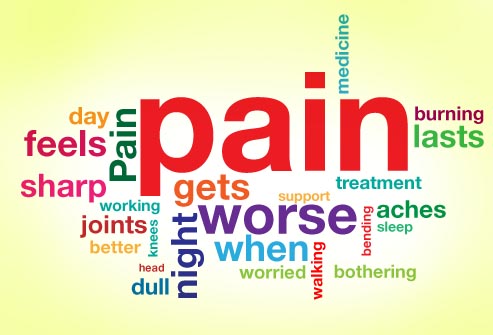Pain. This is a very personal thing. It is complex and an emotional subject. What is extremely painful for one individual, might only be a mild discomfort for another. It is based on your previous life and emotional experiences and also on how well your nervous system is primed or sensitized.
Pain is unavoidable. It lets us know we are alive and is in all aspects of our lives. It is a protective measure for our body to let it know that something is wrong. In saying that, our body will compensate in many ways before it might even recognize there is a problem. If you are experiencing pain, there is normally 90% of the injury that has occurred before your nervous system and brain are registering the area of concern.
Examples of pain are:
* When you break a bone or you feel something sharp you automatically stop moving that part to protect it
* When you touch something that is hot or extremely uncomfortable you withdraw from that object (withdrawal reflex)
Both of these examples are temporary pain and won’t last longer than required, aka acute pain. But when the pain is long lasting, it is then classified as chronic and this pain starts to change the way we move, the way we think, and affects our activities of daily living.
Differences between Acute and Chronic Pain
Acute pain is short lasting and you usually know exactly what caused it. This is pain from trauma, damage from being hit or falling. It is an immediate insult on your body and your brain perceives it as a major problem. This pain should only ever last from 2-4 weeks in most cases. After this it starts to become classified sub-acute then after 12 weeks it is labeled as chronic pain. One thing to note about acute pain is that depending on the situation you are in your body can perceive it differently. E.g. when on a trail run, you brush against a branch which causes a deep cut in your leg which you don’t perceive at all until you finish the race, compared to getting a paper cut which causes intense pain in the area immediately.
Chronic pain is classified as pain that lasts longer than 12 weeks. Most injuries will take approximately 12 weeks to have a normal healing process. This is the average time the body needs for its inflammatory, proliferative, and maturation phases of wound healing to have been completed. Unfortunately, things are not as clean cut for us due to other factors.
It is common for pain to last longer than this course, even if imaging and scans reveal that the tissue has healed.
This is because pain is an interpretation of the total stimuli into the brain. This stimuli consist of but is not limited to tissue damage, inflammation and its chemical outputs, pressure, sight, hot/cold. On top of this, these stimuli depend on your emotional state such as past history, anxiety, stress, life situations and your current circumstances. All of these inputs reflects your body’s ability to report your level of pain and the type of insult that is on your nervous system.
Latest research shows that there can be little correlation between tissue damage and the perceived pain. I have seen two MRI’s of different people that show very similar structural problems, but there is a total difference in the pain reported with one person wincing and able to move and the other person reporting no pain at all.
Psycho-social input has a great influence onto pain and our perception of it. This is classified as stress, anxiety, depression and a belief you can or can’t get better. If you think you have a problem eventually that belief will govern you and you could in fact develop that condition. If you fixate on your pain, it can engulf you and that is all that you become. So when treating chronic pain, it is very important to recognize the condition and how it is impacting the individual. Learning what they are unable to do or what is really important to them and working towards that realistic goal being short or long term. We need to break the pain cycle and have a belief that we are able to move again and move comfortably in the ranges that will test the area.
We know that when chronic pain is present that it is affecting the central nervous system in multiple ways and the way the brain perceives multiple stimuli from our surrounding environment. Chronic pain affects our ability to have proprioception from the area of concern which is the body’s awareness of where it is in time and space. This is very important in movement, balance, and coordination. Chronic pain also affects the body’s ability to discriminate between two-points. This is where the nervous system is able to detect two distinct points on the skin.
Chronic pain sufferers also have sensitization problems. This means their body has lost the ability to negate pain. The body and nervous system from the area has become more sensitive to sensory inputs and the brain has become fixated on the pain.
In essence, a Chiropractor, Osteopath, Acupuncturist, Physical Therapist etc. get us get moving in those early acute phases and manage the pain, which helps the body to have a window of opportunity where the pain is reduced enough to start to get flexibility, strength, and motor control to the area. Like pressing the reset switch on the computer to reboot the system and getting it working more effectively.
Once we regain motor control, our body is able to become more aware and be able to differentiate between sensations so the smallest of insults on our body doesn’t cause over reaction in spasm of muscles and surrounding ligaments. It is being able for your body to have confidence in the ability to move. We also would work on flexibility, which allows us to have ease of motion. It teaches our body in a slow controlled manner that we can go to these end ranges and still be able to return with ease and confidence.
Lastly strength helps mitigate the pain by improving the overall stability of the vulnerable structures.
The best way to decrease and prevent pain issues is to know your weakness and faults and work on them gently and progressively, always trying to increase your strength and flexibility in all motions no matter how old you are. Learning to explore active movement patterns in new and creative ways and understanding that pain doesn’t always mean that damage is being created.
Addressing the underlying issues that are responsible, so you can stabilize your body, move with ease and use the relationship between pain and your nervous system to your advantage.
If you would like more information or would like to book an appointment at Neurohealth Chiropractic – please call the clinic on 9905 9099 or email us admin@neurohealthchiro.com.au or fill in the contact form from our website www.neuro- healthchiro.com.au
Sign up to receive Neurohealth Chiropractic’s Free monthly health newsletter on the Right Hand Side of this page. Filled with great information and lots of easy health tips to keep you at Optimal Health!




